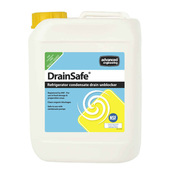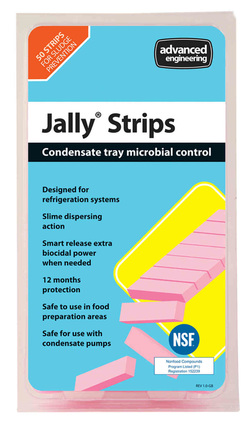03 October 2016
|
|
Bacterial slime in the condensate tray is a leading cause of blown fan motors and refrigerator leaks. Advanced Engineering technical director Colin Pratt explains why it keeps coming back.
Every refrigeration engineer seems to have their own way of removing the thick slime that tends to build up in a retail chiller cabinet’s condensate tray. Pressure washing, steam cleaning, wet & dry vacuums – we’ve even seen footage of contractors competing to suck up the biggest “jelly snake”.
But all these methods have something in common: more often than not, when you make your next scheduled service visit, the slime will be back. And that’s more than just a messy nuisance. When the build-up inevitably blocks the condensate drain line, the water level will start to rise. The least you can expect is a leak, spilling out onto the shop floor as the tray starts to overflow – and if the water reaches the fans? There’s a reason UK retailers buy literally hundreds of thousands of replacement refrigerator fan motors every year. If the fan fails, the coil itself can become encased in a block of ice: hardly ideal for heat exchange.
|
Food safety risks
The chiller might limp on for weeks – leaking, and trying to maintain the set temperature with blown fans and an impaired coil – before the added duty load causes another component to give out.
It’s not ideal for food safety – and that’s before considering the microbes in the condensate tray. We sent samples from a typical UK supermarket for independent laboratory analysis, and they found up to 11 million bacteria living in a single millilitre of condensate slime.
Worryingly, these included biocide-resistant bugs like Staphylococcus, as well as organisms that can cause pneumonia, fever and bloody diarrhoea. All just centimetres away from the food, in a direct flow of air into the cabinet and out into the store.
It’s not ideal for food safety – and that’s before considering the microbes in the condensate tray. We sent samples from a typical UK supermarket for independent laboratory analysis, and they found up to 11 million bacteria living in a single millilitre of condensate slime.
Worryingly, these included biocide-resistant bugs like Staphylococcus, as well as organisms that can cause pneumonia, fever and bloody diarrhoea. All just centimetres away from the food, in a direct flow of air into the cabinet and out into the store.
Content continues after advertisements
Cleaning essential, but insufficient
In order to remove the bacteria fully, it’s important to understand what the slime is, where it comes from, and what it does.
The microbes themselves multiply quickly, because a chiller condensate tray is a perfect environment: moist, and with a constant supply of food particles. As they grow, they excrete an exopolysaccharide layer – the slime we all know.
The exopolysaccharide forms a protective biofilm: a miniature ecosystem where various kinds of microscopic organism can flourish, shielded from biocides and most cleaning agents. Inside the biofilm, germs are 500% more resistant to antibacterial treatments.
Importantly, the polysaccharide is not soluble in water. So even when a cabinet is cleaned thoroughly, small traces remain and begin to grow back immediately. Microbe numbers increase exponentially, so bacterial slime can re-block the condensate tray just weeks after a visit.
The microbes themselves multiply quickly, because a chiller condensate tray is a perfect environment: moist, and with a constant supply of food particles. As they grow, they excrete an exopolysaccharide layer – the slime we all know.
The exopolysaccharide forms a protective biofilm: a miniature ecosystem where various kinds of microscopic organism can flourish, shielded from biocides and most cleaning agents. Inside the biofilm, germs are 500% more resistant to antibacterial treatments.
Importantly, the polysaccharide is not soluble in water. So even when a cabinet is cleaned thoroughly, small traces remain and begin to grow back immediately. Microbe numbers increase exponentially, so bacterial slime can re-block the condensate tray just weeks after a visit.
Step by step
To stop the slime returning so quickly, there are three steps which must always be followed. Before the bacteria can be treated, we need to break down the exopolysaccharide slime into smaller, more soluble molecules. This, in turn, will expose the germs to treatment. Finally, a lasting dose of biocides and surfactants will stop new slime forming.
Crucially, if you’re cleaning a refrigerator for food, all the products you use to complete the process should be NSF-approved for use in food handling areas.
At Advanced, here’s what we recommend:
Crucially, if you’re cleaning a refrigerator for food, all the products you use to complete the process should be NSF-approved for use in food handling areas.
At Advanced, here’s what we recommend:
|
2. Kill all the microbes
Because some of the bacteria found in chiller cabinets are naturally resistant, it’s important to use a cleaner with a cocktail of biocides and surfactants – effective on bacteria, algae and mould. Our CoolSafe cleaner fits the bill – and comes in concentrate or a ready-to-use sprayer. |
|
3. Protect the tray from re-growth
Treating the condensate as it flows through the tray and into the drain, using a slow-release agent to stop microbes growing back. Our new, pink Jally Strips include the blend of surfactants and biocides needed to kill all the relevant organisms. |
Amplify the effects of cleaning
Jally Strips* are not an alternative to a rigorous cleaning and maintenance regime, but they can make its effects last longer – up to a year in most cases – and prevent problems before the next scheduled maintenance visit.
One supermarket told us that adding this essential, final stage has directly contributed to a 3,500 year-on-year reduction in refrigerator condensate leaks. That’s almost ten leaks fewer, every day. It means fewer callouts and a better in-store environment, as well as knock-on savings like a 25% reduction in their expenditure on absorbent floor socks. Happier customers, lower maintenance costs.
Until now, many engineers had considered it inevitable that they’d find slime under a chiller cabinet’s base plate. But with the right process, it can now be as clean as you left it a year ago.
One supermarket told us that adding this essential, final stage has directly contributed to a 3,500 year-on-year reduction in refrigerator condensate leaks. That’s almost ten leaks fewer, every day. It means fewer callouts and a better in-store environment, as well as knock-on savings like a 25% reduction in their expenditure on absorbent floor socks. Happier customers, lower maintenance costs.
Until now, many engineers had considered it inevitable that they’d find slime under a chiller cabinet’s base plate. But with the right process, it can now be as clean as you left it a year ago.
*Where does the name 'Jally Strips' come from?
|
You might wonder why Advanced Engineering called their condensate tray microbial control product 'Jally Strips'.
The company works closely with the University of Surrey through a 'Knowledge Transfer Partnership (KTP)' which helps to research, develop and commercialise new products and solutions. The KTP has been in place for three years during which time Advanced Engineering and the university have been formulating advanced new cleaners and launching unique products. Advanced Engineering was so pleased with the product’s results, they pledged to name the strips after the chemist who invented them, namely Dr. Kajally Jobe, or Jally, for short. Jally is a chemistry research associate at the university. |


















